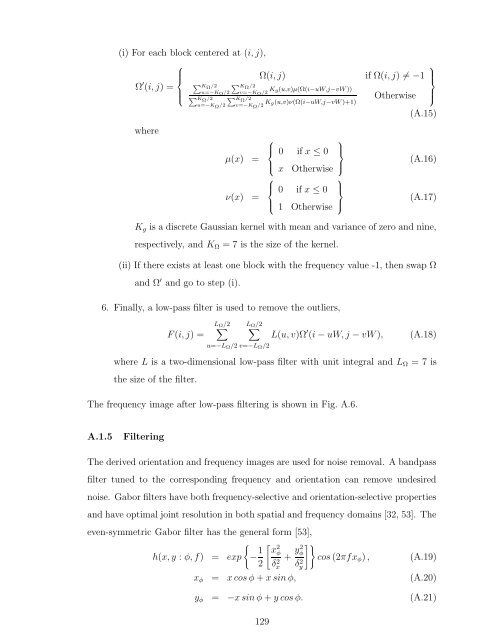Master Thesis - Department of Computer Science
Master Thesis - Department of Computer Science
Master Thesis - Department of Computer Science
You also want an ePaper? Increase the reach of your titles
YUMPU automatically turns print PDFs into web optimized ePapers that Google loves.
(i) For each block centered at (i, j),<br />
Ω ′ ⎧<br />
⎪⎨<br />
(i, j) =<br />
⎪⎩<br />
where<br />
Ω(i, j) if Ω(i, j) �= −1<br />
�KΩ /2 �KΩ /2<br />
Kg(u,v)µ(Ω(i−uW,j−vW ))<br />
u=−KΩ /2 v=−KΩ /2<br />
�KΩ /2 �KΩ /2<br />
Kg(u,v)ν(Ω(i−uW,j−vW )+1)<br />
u=−KΩ /2 v=−KΩ /2<br />
µ(x) =<br />
ν(x) =<br />
⎧<br />
⎪⎨<br />
0 if x ≤ 0<br />
⎫<br />
⎪⎬<br />
⎪⎩ x<br />
⎪⎭<br />
Otherwise<br />
⎧<br />
⎪⎨ 0 if x ≤ 0<br />
⎫<br />
⎪⎬<br />
⎪⎩ 1<br />
⎪⎭<br />
Otherwise<br />
⎫<br />
⎪⎬<br />
Otherwise ⎪⎭<br />
(A.15)<br />
(A.16)<br />
(A.17)<br />
Kg is a discrete Gaussian kernel with mean and variance <strong>of</strong> zero and nine,<br />
respectively, and KΩ = 7 is the size <strong>of</strong> the kernel.<br />
(ii) If there exists at least one block with the frequency value -1, then swap Ω<br />
and Ω ′ and go to step (i).<br />
6. Finally, a low-pass filter is used to remove the outliers,<br />
F (i, j) =<br />
LΩ/2<br />
�<br />
LΩ/2<br />
�<br />
u=−LΩ/2 v=−LΩ/2<br />
L(u, v)Ω ′ (i − uW, j − vW ), (A.18)<br />
where L is a two-dimensional low-pass filter with unit integral and LΩ = 7 is<br />
the size <strong>of</strong> the filter.<br />
The frequency image after low-pass filtering is shown in Fig. A.6.<br />
A.1.5 Filtering<br />
The derived orientation and frequency images are used for noise removal. A bandpass<br />
filter tuned to the corresponding frequency and orientation can remove undesired<br />
noise. Gabor filters have both frequency-selective and orientation-selective properties<br />
and have optimal joint resolution in both spatial and frequency domains [32, 53]. The<br />
even-symmetric Gabor filter has the general form [53],<br />
�<br />
h(x, y : φ, f) = exp − 1<br />
� ��<br />
2 xφ cos (2πfxφ) , (A.19)<br />
2<br />
δ 2 x<br />
+ y2 φ<br />
δ 2 y<br />
xφ = x cos φ + x sin φ, (A.20)<br />
yφ = −x sin φ + y cos φ. (A.21)<br />
129










